
A conventional photographer is one who works with a camera that requires film and conventional developing and printing processes. With the advent and widespread use of digital photographic processes, traditional cameras and conventional photography have become less common in mainstream use. Professional photographers, however, continue to use these methods, and many students studying photography and art are required to learn conventional photographic processes.
Background
Prior to the popularization of digital processes, photography was not separated into two distinct subgroups. Film cameras and darkroom processing have been used by professional photographers since the 1850s. Cameras have been widely available for consumer use since the first half of the 20th Century.
Differences Between Digital and Conventional Photography
Conventional photographers must use film to take pictures. Film rolls typically provide 24 to 36 frames. These film rolls must be developed and printed in a laboratory to produce pictures. The process can take hours, depending on the type of photo. Digital cameras do not require film. Pictures can be stored on a compact flash card, or CF card, which lets photographers transfer the digital picture files from the camera to a computer for editing.
Conventional Photography Processes
Conventional photographers are typically trained in darkroom processes that let them develop and print pictures from film. In a traditional darkroom process, film must be developed in chemicals. After developing, the negatives are inserted into an enlarger, and the photographer prints the photographs onto photo paper. This allows the photographer to make custom prints on his choice of photo paper. Conventional photographs can also be printed by companies that offer developing and printing services done by machine. The photographer keeps the photo negatives, allowing him to make future prints as desired.
Advantages of Conventional Photography
Despite the popularization of digital photography, many professional photographers continue to use conventional cameras and printing processes. Wedding photographers, for example, often prefer to take portraits with conventional cameras. That's because darkroom film development lets them control the contrast and quality of prints. Hand printing photographs also lets photographers produce one-of-a-kind images that can not be created through digital processes.

A conventional photographer is one who works with a camera that requires film and conventional developing and printing processes. With the advent and widespread use of digital photographic processes, traditional cameras and conventional photography have become less common in mainstream use. Professional photographers, however, continue to use these methods, and many students studying photography and art are required to learn conventional photographic processes.
Background
Prior to the popularization of digital processes, photography was not separated into two distinct subgroups. Film cameras and darkroom processing have been used by professional photographers since the 1850s. Cameras have been widely available for consumer use since the first half of the 20th Century.
Differences Between Digital and Conventional Photography
Conventional photographers must use film to take pictures. Film rolls typically provide 24 to 36 frames. These film rolls must be developed and printed in a laboratory to produce pictures. The process can take hours, depending on the type of photo. Digital cameras do not require film. Pictures can be stored on a compact flash card, or CF card, which lets photographers transfer the digital picture files from the camera to a computer for editing.
Conventional Photography Processes
Conventional photographers are typically trained in darkroom processes that let them develop and print pictures from film. In a traditional darkroom process, film must be developed in chemicals. After developing, the negatives are inserted into an enlarger, and the photographer prints the photographs onto photo paper. This allows the photographer to make custom prints on his choice of photo paper. Conventional photographs can also be printed by companies that offer developing and printing services done by machine. The photographer keeps the photo negatives, allowing him to make future prints as desired.
Advantages of Conventional Photography
Despite the popularization of digital photography, many professional photographers continue to use conventional cameras and printing processes. Wedding photographers, for example, often prefer to take portraits with conventional cameras. That's because darkroom film development lets them control the contrast and quality of prints. Hand printing photographs also lets photographers produce one-of-a-kind images that can not be created through digital processes.
Lytro Light Field Camera: Digital Photography Review
www.dpreview.com/reviews/lytroDigital Photography Review: All the latest digital camera reviews and digital imaging news. Lively discussion forums. Vast samples galleries and the largest database ...
Understand what is Aperture in photographic basic
www.mir.com.my/rb/photography/fototech/apershutter/aperture.htmShutter speed, apertures and depth of field, three most important elements in photography. I have been through the early days of confusion, hope this will help.
Photography Tips, Tricks and Techniques
www.photographytips.comLearn better digital and conventional photography whether you're a beginner, an advanced amateur or a professional. Discover how to pose models, photograph your ...
What conventional medicine won't dare tell you about gall bladder ...
www.naturalnews.com/007733_gall_bladder_surgery.htmlWhat conventional medicine won't dare tell you about gall bladder removal surgery
What's new @ CES 2013: Digital Photography Review
www.dpreview.com/articles/4090874271Digital Photography Review: All the latest digital camera reviews and digital imaging news. Lively discussion forums. Vast samples galleries and the largest database ...
WHAT IS STREET PHOTOGRAPHY ALL ABOUT? Loy Chuan Photography
www.loychuan-photography.com/2011/08/what-is-street-photography...What Is Street Photography? According to Wikipedia, street photography is a type of documentary photography that features subjects in candid situations within public
What are non conventional sources of energy - The Q&A wiki
wiki.answers.com Science Energy Nuclear EnergyAnswer The non-conventional sources of energy are: 1. Wind Energy advantages- non-polluting; low cost production of electricity once setup; safe and clean ...
r - What is the conventional definition of recurrence-free ...
stats.stackexchange.com/questions/33132/what-is-the-conventional...Cross Validated is a question and answer site for statisticians, data analysts, data miners and data visualization experts. It's 100% free, no registration ...
0 comments:
Post a Comment